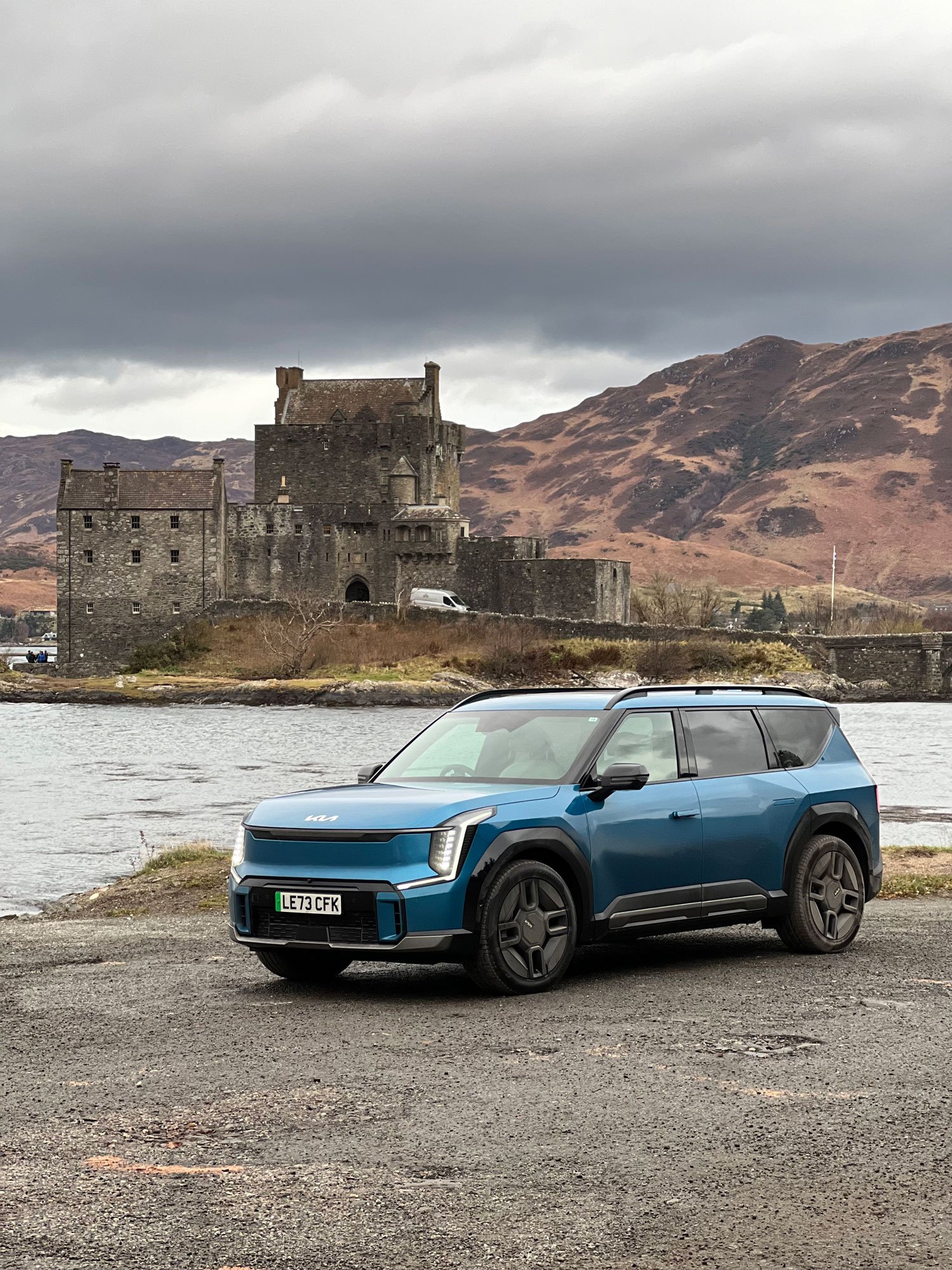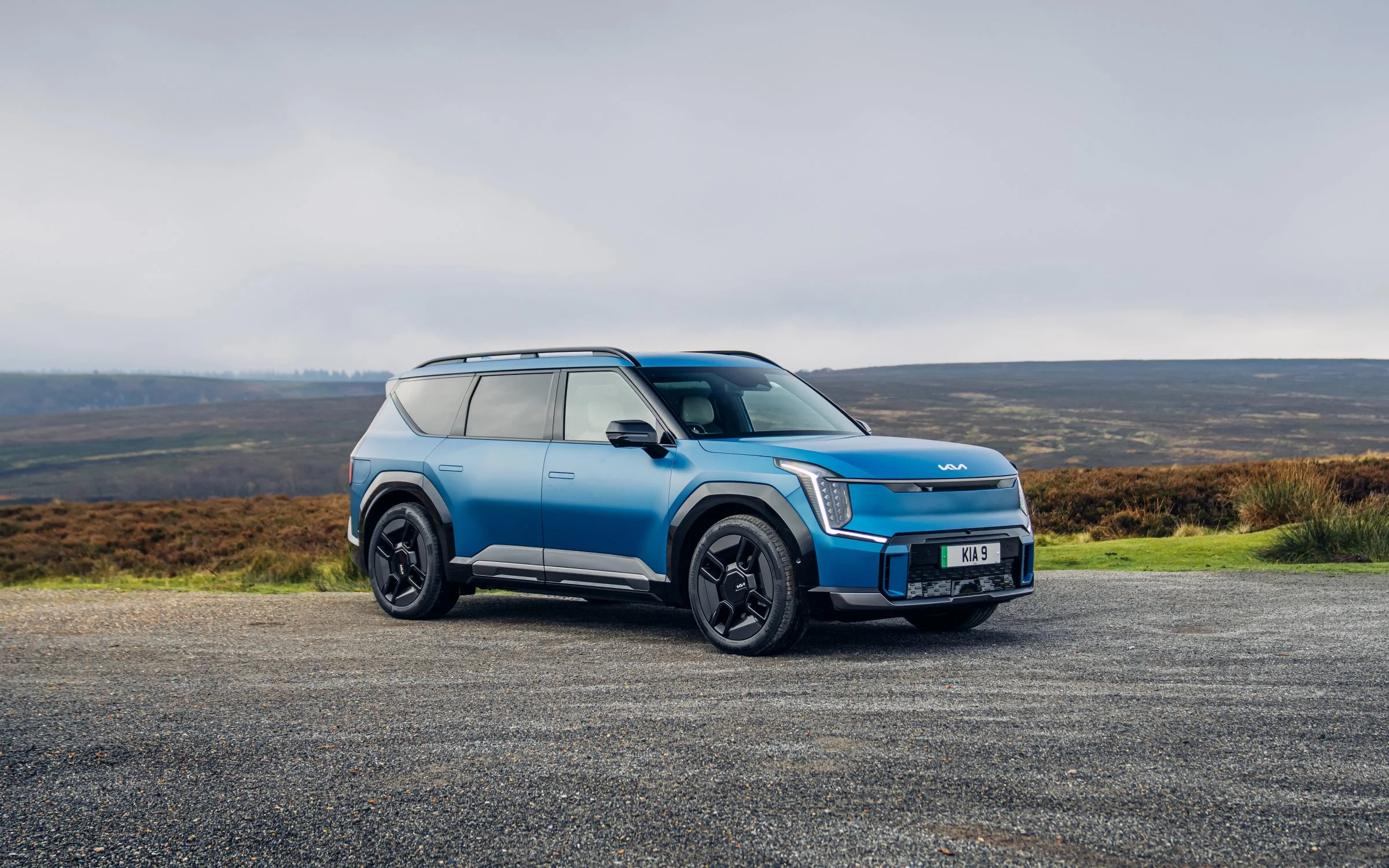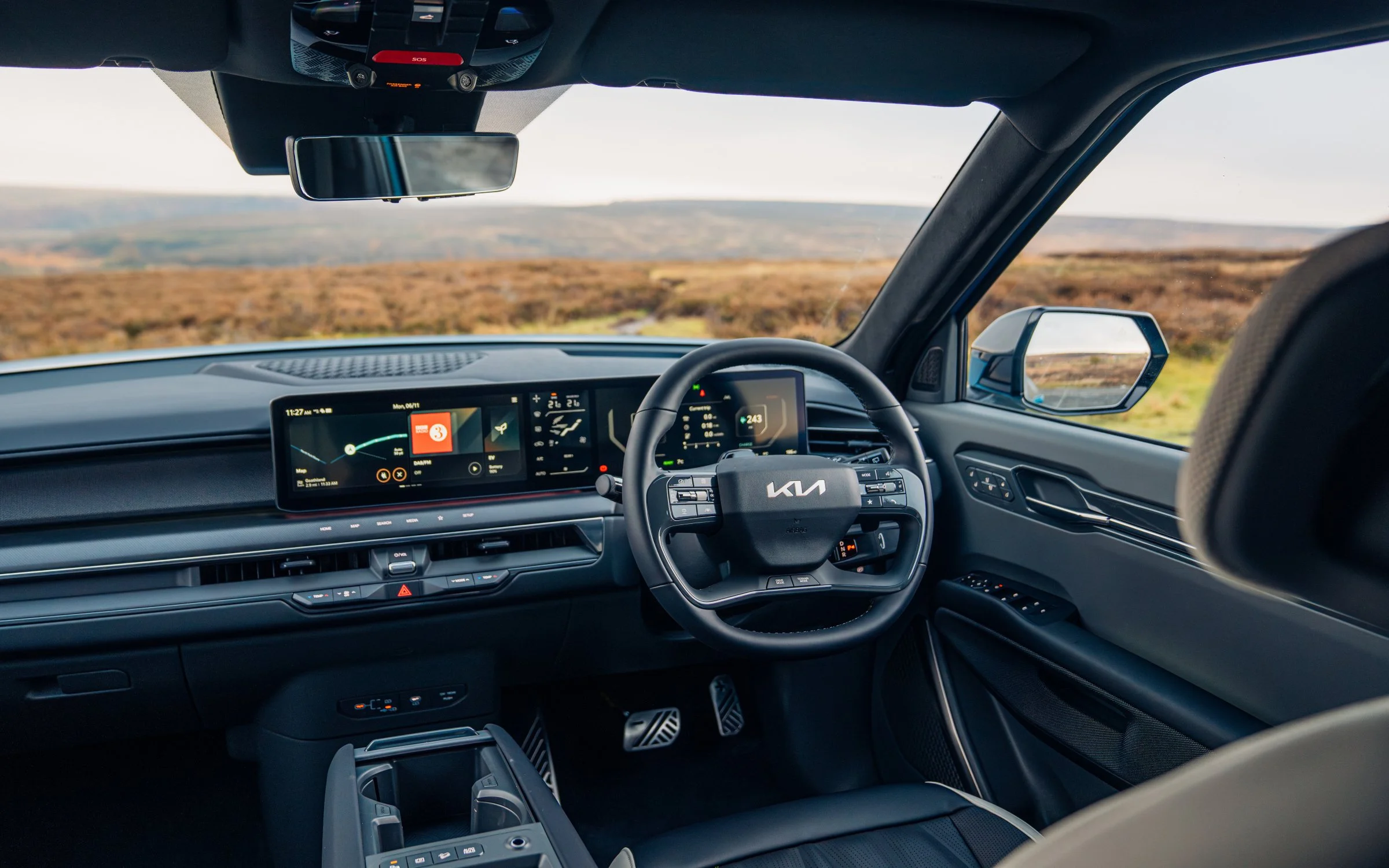Kia EV9 - The First 7-Seat eSUV
At the time of typing, we’re approaching the end of the year 2023 and looking ahead to 2024. A new year typically means we’re at the time of new beginnings, promised pledges and resolutions - most of which are likely to be broken by January 30th. Also new for 2024 is a new Kia, it’s called the EV9, and it’s a significant car for many reasons, not only for Kia but the automotive industry as a whole.
The EV9 is the latest model from the South Korean brand, which showcases a new era for its EV models and is the most expensive Kia to date. It’s also the brand’s first-ever 7-seat eSUV and, subsequently, the first of its kind from any manufacturer globally. Like its sister company, Hyundai, Kia is a brand going from strength to strength, demonstrating one of the fastest accelerating evolutions in the industry for build quality, brand reputation and desirability. In recent years, the public perception of the Kia badge has evolved from being the affordable version of the European staple car brand to something as appealing as the high-end favourites like BMW and Audi, and now, thanks to the new car’s size, Land Rover.
Kia is calling the EV9 a flagship for the brand, and rightly so - to call it a jump in progression from previous models would be an understatement; this thing is a leap.
There are three trim options for EV9 buyers, offering a slightly different list of options, power and range. The entry-level model ‘Air’ will retail from £64,995. ‘Air’ is rear-wheel drive only and has a power output equivalent to 200bhp, 350Nm of torque and a claimed (approved by WVTA) range of 349 miles.
The next option on the list is ‘GT-Line’, retailing from £73,245, which rewards options such as sportier styling, larger wheels, upgraded exterior lighting and upgraded seating. ‘GT-Line’ drives all wheels thanks to two motors and offers increased power with 378bhp and 700Nm of torque, and has a verified range of 313 miles.
The top-spec for buyers at launch is ‘GT-Line S’, which retails from £75,995. ‘GT-Line S’ has the same power output and range as ‘GT-Line’ but offers additional gadgetry such as a head-up display and an upgraded 14-speaker Meridian sound system.
In typical Kia fashion, the list of standard equipment in all models is staggering and includes Apple CarPlay/Android Auto, wireless phone charging, heated and ventilated seating, electric folding and heated wing mirrors, rain-sensing wipers, a switchable mirror to screen rearview, LED headlights and rear lights, rear window tints with manual sun blinds, duel zone air conditioning, a heated steering wheel, an electronic tailgate, six USB-C socket points (2 per row), a 3 pin socket in the boot, intelligent cruise control that links to the in-built satellite navigation, steering assist, blind spot assist, lane keep assist, 360-degree surround cameras, and, a total of nine airbags inside the cabin for maximum occupant safety.
For the UK launch of the EV9, I joined several industry colleagues on a flight from London Stansted to Inverness airport, where I was immediately greeted with a key to an EV9 that I’d be driving for the next 2 days around the Scottish Highlands. This is not only the most expensive Kia to date, it’s also the largest by quite some margin. The GT-Line S I’d be testing is a few millimetres over 5 metres in length and is just shy of 2 metres in width. At 1.8 metres in height, it’s in the same ballpark in terms of size as the new Land Rover Discovery or Defender 110.
Sat waiting for me outside the main entrance to Inverness airport was my very own EV9 GT-Line S finished in the striking colour of Pacific Blue and I allowed myself a moment to admire the car’s design. This is a car that was first shown as a concept in late-2021. The striking, bold lines and boxy design rightfully grabbed lots of attention at the AutoMobility Show in Los Angeles. It was a very typical concept in appearance and proved radically different to Kia’s design language to date. I doubt many that saw the concept (in person or via a screen) back in November ’21 ever imagined the production car would be even remotely similar in its radical design - and yet here I am, standing outside a tiny airport in the Scottish highlands, thinking, “blimey, they’ve only gone and made it!”
The EV9 looks imposing in style. The lines are almost brutalist - there is absolutely nothing subtle about it. It’s big, it’s innovative and, dare I say it, quite appealing. At the front, there are no typical headlight units. Instead, two verticle lines of LEDs provide a dipped and main beam. This design is on par with something you would expect to see on a superhero’s car in a cartoon. On paper, you would be forgiven for thinking that ‘surely, that’ll never work’, and yet it does - brilliantly. The door handles sit flush with the panels until unlocked, at which point they slide outwards, revealing themselves as grips, to later slide back in to cancel out any risk of wind noise once you have sat inside and shut the door again.
Inside the car, the space has been designed and managed very well. In the driver and front passenger seat, the space around your legs is more comparable to a van than a car, thanks to the lack of a transmission tunnel that typically runs through the centre of SUVs to house a gearbox and a driveshaft. Kia’s ‘Electric Global Modular Platform’ (aka E-GMP) allows for a completely flat floor within the cabin, maximising the feeling of space. This sense of space is aided by the seemingly floating centre armrest and a high seating position.
The interface of the dashboard console and infotainment screens is minimalist, with one extensive 3-in-one screen offering touchscreen access for all elements and accessories. Everything from climate control to media and navigation is controlled via the one console and a few choice buttons below. Directly ahead of the steering wheel are the dials for speed, driver assists and information on range and battery charge levels. The next screen to the left is a small panel for climate control. The third section of the screen, which stretches to the centre of the car, accommodates car settings, media controls and navigation. The entire interface is intuitive, easy to grasp, and in keeping with the design style elsewhere inside the car.
The seating is exceptionally comfortable, with multiple levels of electronic adjustment as standard. Heating and ventilation are standard up front and on the two outer rear seats on the second row. If the GT Line or higher is specified, the driver seat also features additional luxury with an in-built massage feature. With comfort, climate and a massage all working their magic, it was time to head towards the Highlands and put the EV9 through its paces on the road.
In typical big-power-EV fashion, the EV9 feels ludicrously quick for its size. Despite its 2.6-tonne kerb weight, two motors pushing 700Nm of torque launch the SUV from a standstill or an already significant rolling speed as if it’s a car 1/3rd of its weight. Of course, when cornering and braking, the true weight is felt - this is an increasingly common factor with performance EVs and not something worth complaining about as, frankly, we can’t change physics.
I found that the suspension damping is well suited to all speeds. The ride is soft and compliant at slower speeds, ideal for driving around town but the ride really comes into its own at higher speeds. On the national speed limit roads, the EV9 floats along the scenic roads between 40-60 MPH, soaking up any lumps, bumps, and undulations beautifully. The EV9 has been designed to minimise wind noise, and the soundproofing to reduce road noise is equally impressive, given the 21-inch Pirelli P Zero tyres.
A plethora of driver assists and aides come as standard on the EV9, some of which are a blessing, and others can become tiresome and ant times, annoying. The assisted cruise control, integrated with the navigation system, is superb, as is the steering assist (lane keep assist), which keeps the car centred in the lane and will even steer around corners on your behalf. The system will steer for you, but it’s not designed to be relied on and will politely remind you as the driver to place your hands back on the wheel after 10 seconds or so in the event that you might remove them for experimental reasons.
Two features designed in mind for safety are speed limit warnings and driver attention alerts. I see the benefit of both, but I was pleased to find the override setting to switch both off. The speed alert gives a series of bongs at the very moment that you drive at even 1 mph over the shown speed limit, which the in-built camera systems don’t always get right. I endured a couple of instances when driving on a national speed limit road (60mph limit), which the car had incorrectly recognised as a 40mph road - cue a series of infuriating pings and bongs with the car assuming I was being a wreckless maniac by driving 20mph faster than it thinks I should be.
The other frustrating feature has equally significant intentions but isn’t flawless in its delivery. A small sensor on the top of the steering column looks through the steering wheel and directly at the driver’s face. If, at any moment, the sensor deems the driver to not be paying attention or looking forward for a long enough period of time, an additional sequence of pings and bongs will play through the speakers. All of the safety alert features can be disabled; however, as found when recently reviewing the Kia’s distant cousin, the Hyundai IONIQ 6, once the car has been switched off and then turned back on again, all the settings are switched back on by default to comply with safety regulations and will need individually disabling once again.
Safety alerts and annoyances aside, as both a driver and a passenger, inside the EV9 is an extremely pleasant place to be. The interior is packed with sustainably sourced and eco-friendly materials as part of the company’s vision to be as clean and green as possible. The dashboard is made from a type of bioplastic. The floating centre console, interior pillar covers and trim are made from renewable biomass sources such as corn extract, sawdust and sugar cane. Door trims are made from recycled and repurposed plastics, and what appears to be leather is actually a Bio-polyurethane. Elsewhere on the seats, the plastics used for the seat structures and accessories consist of as many as 70 recycled plastic bottles. Everywhere you look inside the EV9, there is some form of recycled, repurposed, or sustainable material - including the floor mats and carpets, which are made from recycled fishing nets. This sustainable approach to car building is now standard practice for Kia moving forward as part of the brand’s ‘Plan S Strategy.’
In terms of space and convenience, you would be hard-pushed to run out of interior storage with ample bins, pockets and compartments up front. The space in the car’s rear is equally ample, thanks to the flat floor and flowing design style. If the 6-seat option is specified, the second row can rotate 180 degrees for backwards-facing travel. Even in the 3rd row, there is enough space to accommodate all 6’1 of me, meaning it’s ideal for young children through to teenage years. Naturally, with the third row in use, you may fear it compromises boot space, but again, thanks to Kia’s clever design, you’re still rewarded a generous 333 litres of space with the 6th and 7th seats in use - and almost twice that when stowed away. Under the bonnet is an additional storage box with 52 litres of space.
Thanks to Kia’s fourth-generation battery technology with a 99.8kWh Li-ion polymer battery, the charge times for all models in the range are very impressive. The GT-Line S (as tested) will charge on a 350kW charger from 10-80% in just 24 minutes. At 50kW, 10-80% is achieved in 1 hour 23 mins, and a box-wall charger at home (@ 230v / 48A) will reward a comfortable overnight charge of just over 9 hours, charging the battery from 10-100% charge in that time.
In my two days with Kia’s new flagship eSUV, I concluded that there is a whole lot to like and as a result, I predict that the arrival of the Kia EV9 will severely disrupt long chains of brand loyalty for car buyers worldwide.
The brand has succeeded in producing not only the first-ever 7-seater SUV EV but also a car that’s likely to be a first Kia purchase for many buyers who will have previously looked toward the familiarity of European-branded SUVs. The price tag is significant but by no means ridiculous. Competitor cars have yet to make an appearance; however, when they do, I can’t imagine that an EV version of the Land Rover Discovery or Volvo XC90 will represent better value than the EV9 offers.
Another perk for the consumer is Kia’s generous warranty as standard. The EV9 includes a 7-year or 100,000-mile warranty, a 12-year unlimited anti-perforation warranty, and a 5-year or 100,000-mile paint warranty. And if that wasn’t enough, Kia also includes 1 year of Kia roadside assistance as standard with every purchase.
The EV9 looks excellent, drives brilliantly and features enough practicality, safety and technology to appease even the most focused of badge snobbery. The EV9 is more than just a cool-looking SUV. I firmly believe it’s a car that represents Kia’s turning point and will be remembered for doing so in many decades to come.
Words & Pictures: John Marcar
Additional Images: Kia UK


























